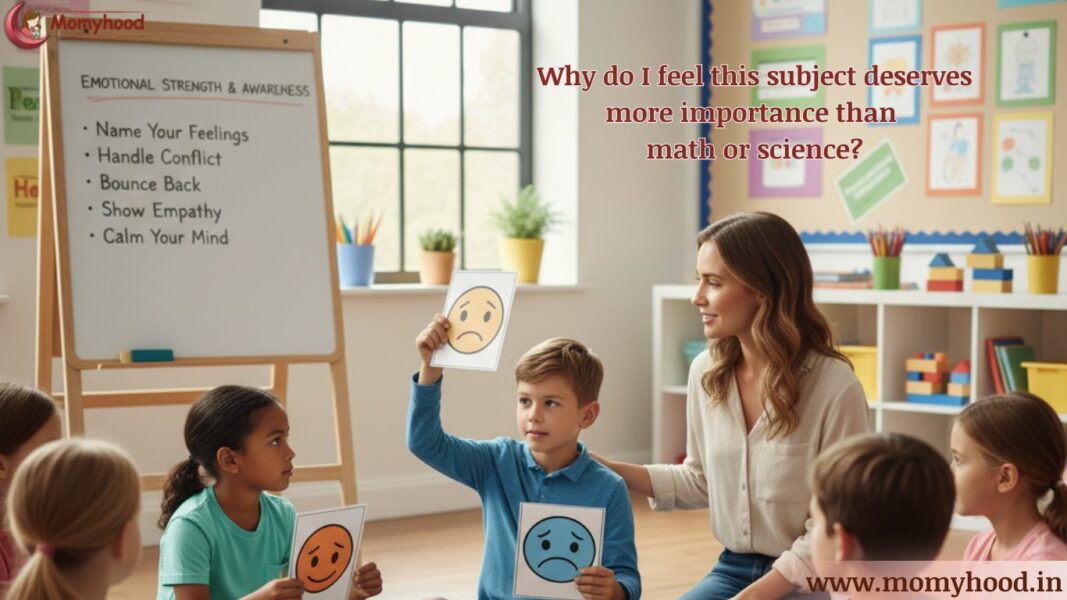Every few weeks, I scroll through the news — and my heart sinks all over again. Another story. Another young life lost to suicide. Another family shattered. And I sit there thinking—how did we get here? How are we losing so many of our children when we should be building their emotional strength?
According to the World Health Organization (WHO), suicide never results from a single event—it’s a mix of many complex factors. Yet, when we look closely, a simple truth emerges — our children lack the emotional strength they need to face challenges confidently. Building real emotional strength for children has never been more important.
It’s not that today’s generation is weak—it’s that we, as a society, forgot to teach them how to cope.
Starting at Home: Where Emotional Education Begins
As a mother, this isn’t just a social issue—it’s personal. And I realize the foundation of emotional strength for children begins at home.
I often find myself explaining emotions to my six-year-old—what sadness means, what anger feels like, and why it’s okay to express both. For example, when my son says, “Mumma, I’m angry,” I don’t tell him to stop. Instead, I help him name that feeling and talk about it.
But here’s the big question—if we parents are doing this at home, why isn’t emotional education a part of the school curriculum?
Don’t get me wrong—I’m glad I can be there for him. But where’s the backup? Where’s the education system in all of this? We’re so focused on preparing our kids for careers, for exams, for college admissions. But who’s preparing them with the emotional strength that they need to survive?
📣 Loved what you read? Want to go deeper into conscious parenting? ✨ The Power of Manifestation in Parenting is now available — A soulful guide packed with real-life tools like affirmations, energy shifts, and sleep talk that I personally use with my son, Hitarth. 💛 Start your journey toward calmer, connected parenting today. 🎉 Launch Offer: Only ₹99 (limited-time price!) 📲 Instant download. No waiting. 👉 Grab your copy now!.
The Stories That Haunt Me
The scariest part? It’s not always the big, dramatic things that break our children. Sometimes it’s the “small” stuff. The everyday moments that should be manageable but become unbearable when kids lack emotional strength.
The Scolding That Crushed a Young Man
There was this 19-year-old delivery guy. A customer yelled at him, humiliated him over a late delivery. That was it. That was the last straw. (India Today and The Economic Times covered this heartbreaking story.)
One harsh word. One moment of shame. And a young life was gone.
This isn’t about a delivery—it’s about how fragile emotional coping has become when self-worth is tied to others’ reactions.
A Simple Parental Scolding, an Irreversible Tragedy
In another tragic case: a Class XII student took her own life after her dad scolded her about phone use. A completely normal parenting moment. The kind of thing that happens in households everywhere. But for this girl, it was too much. (The Hindu reported on this tragedy.)
Do you see what I’m saying? These aren’t isolated incidents. These are symptoms of children who were never taught emotional strength—the resilience they desperately needed.
These stories remind us that our children aren’t learning how to handle emotions. They’re learning how to hide them.
Also read: 5 Easy Ways To Nurture Emotional Intelligence In Kids
It’s Not Just About Suicide—It’s About Everything
Here’s something else that terrifies me: the violence. Kids are hurting each other. Bullying has reached disturbing levels. We’re hearing about children—children—committing acts of violence against their peers, sometimes even inside school premises.
In one recent case in Ahmedabad, a Class 10 student lost his life after being stabbed during a fight on campus. What’s even more heartbreaking is that he lay bleeding for nearly 30 minutes without help, while staff reportedly focused on cleaning up the blood instead of rushing him to the hospital.
This is not just about school negligence — it’s about emotional collapse. A moment of uncontrolled anger turned into an irreversible tragedy.
When children lack emotional strength — when they don’t know how to handle anger, jealousy, or rejection — even small conflicts can explode into devastating acts.
This isn’t just one incident — it’s a mirror showing what happens when emotions go untrained and unmanaged.
Kids are brilliant academically, sure. They can solve complex equations and write sophisticated essays. But ask them to navigate a conflict? To handle disappointment? To sit with uncomfortable feelings without exploding or imploding? They have no idea where to start.
They struggle to say, “I’m hurt,” or “I feel left out.”
They don’t have the words. They don’t have the strategies.
They don’t have the emotional strength we should have given them.
It’s not their fault. We simply never taught them how to feel safely.
Building Emotional Strength for Children: What We Can Do Now
So what can we, as parents and educators, actually do? How can we teach emotional strength for children in ways that fit into everyday life?
I’ve decided to write to my son’s school, requesting something that should already exist: a mandatory weekly session on Emotional Strength and Awareness.
Not therapy. Not counseling for “troubled kids.” A class. A subject. For everyone.
Imagine if emotional strength for children was taught just like math or science.
Our children would learn, through stories, role-play, and real-life examples:
How to name their feelings:
For instance, when a child says, “Mumma, I’m angry,” teachers and parents can guide them to say, “I’m upset because I didn’t get a turn,” instead of yelling or crying.
This builds emotional vocabulary and self-awareness.
How to handle conflict:
Schools can introduce small “emotion circles,” where kids share one thing that made them angry or sad and discuss peaceful ways to resolve it.
They’ll learn that disagreement doesn’t mean disrespect.
How to bounce back:
After losing a competition, a teacher can remind children — “You didn’t lose, you learned.”
Simple affirmations like this teach resilience — that failure isn’t fatal, and disappointment is survivable.
How to see each other’s pain:
Through empathy activities — like writing kind notes, helping a friend, or reflecting on how others feel — children can learn compassion early.
They begin to notice when someone’s struggling, instead of teasing or isolating them.
How to calm their minds:
A few minutes of guided breathing, gratitude journaling, or visualization before class can do wonders.
These tools regulate emotions and reduce stress, anger, and anxiety.
These small lessons build a lifetime of strength.
Because no exam, no grade, no medal can protect a child who feels lost inside.
Related read: 10 therapist tips to raise emotionally strong kids in a chaotic world.
Why Emotional Strength for Children Can’t Wait
I get it. Schools have packed schedules. There’s always pressure to add more math, more science, more test prep. But here’s my question: What good is academic success if our children don’t survive to enjoy it?
Developing emotional strength for children isn’t a luxury—it’s a necessity. We need to nurture the heart as diligently as we nurture the mind. We need to teach them how to handle the world inside their heads. Because until our education system prioritizes emotional strength for children, no amount of grades or achievements will keep them truly safe.
So I’m asking you: Do you think teaching emotional strength for children should be mandatory in schools? Would you be willing to request this to your school administration?
If this message resonated with you, share it with your child’s school or other parents. Together, let’s make emotional strength a part of every child’s education.
Your comments and shares do more than just support our blog—they uplift the amazing moms who share their stories here. Please scroll down to the end of the page to leave your thoughts, and use the buttons just below this line to share. Your support makes a big difference!



